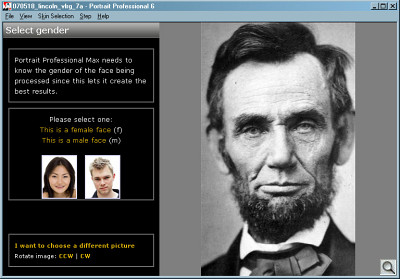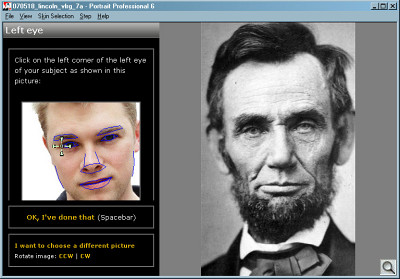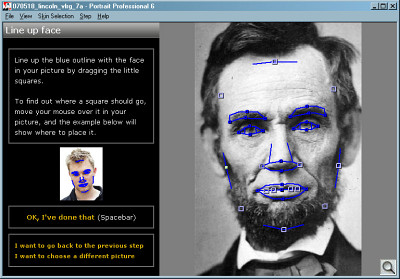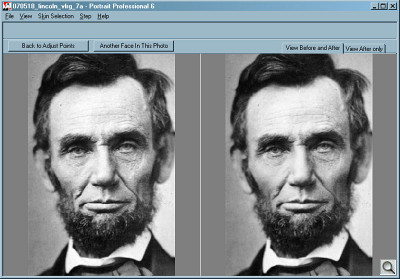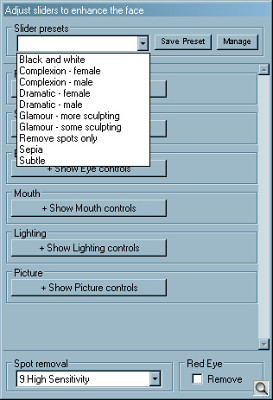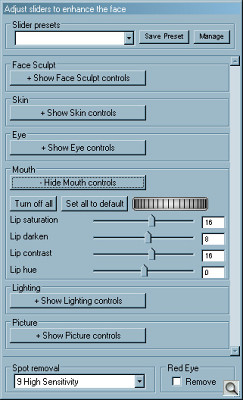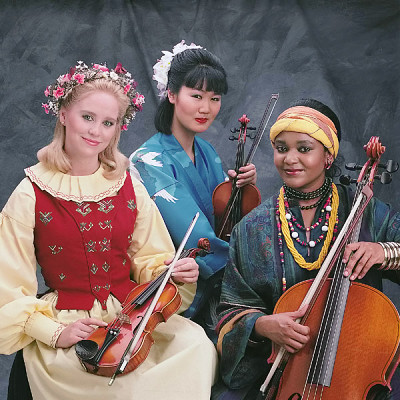THE ART OF FLATTERY
Portrait Professional -- Automated Makeovers
Editor
The Imaging Resource Digital Photography Newsletter
Review Date: July 2007
When we stroll through one of those portrait galleries full of Thomas Eakins and James McNeill Whistler, we wink at the wealthy patrons they portrayed and mumble under our breath, "You never looked so good."
In fact, they didn't. The broad brush that laid in the flesh tones of their faces didn't lend itself to pore-level detail. The highlight dabbed into their eyes was an old trick that couldn't be relied on in real life. Much was left to suggestion, diplomatically avoiding the distractions of blemishes and scars.
Photographic portraiture has by nature been forced to be less ambitious, confining itself to soft focus, narrow depth of field, whitening teeth and sharpening eyelashes with some airbrushing of blemishes. The real art is in lighting the subject appropriately. Flatteringly.
In short, portraiture has always been about flattery. The artist's job has always been to "convey the subject's personality."
So it shouldn't surprise us that someone would sooner or later automate the flatter's art for portrait photographers. Anthropics Technology has indeed done just that with Protrait Professional, a very simple-to-use application that applies the tricks of the trade to any portrait.
But the program can go a bit beyond what photographers do, approaching the control of a portrait painter when it comes to the shape of the face. You decide just where to draw the line, though, using simple sliders to adjust the corrections and saving those adjustments as a preset.
WHO ARE THESE GUYS | Back to Contents
Anthropics Technology (http://www.anthropics.com/) was launched in 1997 as the research division of the U.K.'s National Film and Television School, the rough equivalent of the American Film Institute. Initially it was awarded three years of government funding to "explore the future of the media."
Over the past few years, in conjunction with researchers at several British universities, it has been developing Portrait Professional as a new form of photographic retouching software. The universities involved are:
- Cambridge University, home of the chief scientist, with whom Anthropics still has close research links
- York University, where the face and facial feature finding technology was developed by a York research group
- Oxford University, which has both supplied the company with researchers and undertaken a number of research programs funded by Intel and others
- Manchester University, which did some very interesting and pioneering initial work in face representation and animation
Their research led to the unique technology in Portrait Pro that can succinctly describe any human visage. "Essentially we now had a sparse representational model of human faces," CEO Andrew Berend told us, "that could be trained in beauty by being shown hundreds of well-shot, well-lit photographs of beautiful and not so beautiful people. All the software was told for any given face was 'this is beautiful' and 'this is not beautiful.'"
Berend continued, "This means that once a few points on the face have been identified, a user can add attractiveness to a particular face simply by moving sliders. The clever bit is how the software retains the person's identity while subtly improving their appearance.
"It's very easy to make someone more beautiful by simply morphing them towards a beautiful person such as Jessica Alba -- but this progressively destroys their identity as they become more like Alba and less like themselves. We avoid this and can subtly enhance many aspects of a persons appearance while retaining their identity really well."
Berend told us that the large German portrait lab Thielefoto, which processes over three million portraits a year (mostly school portraits), recently tested skin and face enhancing software -- including custom Photoshop applications and high end dedicated professional lab applications from companies like Kodak -- and selected Protrait Pro. That resulted a batch mode version of Protrait Pro for the lab with an enhanced spot remover.
FEATURES | Back to Contents
We tested four versions of Portrait Pro (http://www.portraitprofessional.com) from version 5.0.4 through 6.0. Version 6 of the application is available in a $59.95 standard version or in a Max version with 16-bit channel and Raw file support for $99.95.
A free trial version (http://www.portraitprofessional.com/download) is also available. Anthropics requests your email address, but it isn't required to download the demo.
Throughout our testing of the various versions, several key features remained constant:
- Facial feature identification requires you to manually mark five easily-found spots on a face
- Sliders determine how far you move from the reality of the portrait (no correction) toward an idealized model based on the company's research
- Very little skill is required to make the default modifications but adjustments other than racheting the default back toward the reality require a something more than expertise
That ease of use is applied to making a wide range of adjustments to the image. Those include:
- Face reshaping. By using specific sliders you can enlarge or reduce the forehead, raise or lower the jaw and change the position of the nose up or down, in or out. This feature extends to moving eyebrows, reshaping eyes and moving lips, too. But as Anthropics notes, "We have found this unique feature of Portrait Professional to be the most contentious, since some regard actually changing the shape of the face as going to far when enhancing an image. For those people, the shape sliders can of course be left at zero and Portrait Professional will not change the shape. However, before dismissing this effect as 'cheating,' we urge you to try it -- you will be amazed that sometimes a very subtle change to the shape can lead to a dramatic improvement to the subject!"
- Skin enhancement. The program's ability to detect skin depends to a large extent on using a color image. But where it can find skin, the sliders can be adjusted to reduce or remove pores, wrinkles, spots and other blemishes. We found the preview wasn't quite accurate in revealing how well the program could retain skin texture while eliminating blemishes. Zoom in.
- Eyes and teeth whitening. Sliders again can adjust the degree to which eyes and teeth are brightened. We found the defaults to be quite pleasing.
- Red Eye Removal. A simple checkbox handles red-eye removal.
Version 6, to be released next week, includes the following enhancements:
- The software no longer requires an internet connection for image processing
- An improved touch up brush, which is much more subtle in its effect and preserves more skin detail
- An improved spot remover, which is now is "pretty much magic in its effect on clearing up skin defects while leaving the skin very natural."
- An improved user interface, which makes finding the controls for new users easier
- Improved three-quarter view handling after more three-quarter view images were added to the data set to improve realism
SYSTEM REQUIREMENTS | Back to Contents
The program runs only under Windows 2000/XP/Vista, with no plans for a Mac version at this stage of the game. Version 6 of the application itself requires very little disk space, just a modest 1.3-MB with a 364K DLL. Some of the facial feature support files are larger than the program, in fact.
Anthropics recommends using a computer with at least a 1-GHz processor and 512-MB RAM. To handle large images (8-Mp or more) you should have 1-GB or more RAM.
Internet access has been required in versions prior to access the Anthropics server "to calculate point data for the face shaping." The image itself was not transmitted, just the data required by the company's novel algorithms. Anthropics did not want to distribute those algorithms with the application because "our investors were keen to keep these secure." With version 6, the company is responding the increasing number of users who have requested a stand-alone version.
There is a FAQ (http://portraitprofessional.com/faq) on the Web site, although it's not easy to find the link.
INSTALLATION | Back to Contents
After the painless and quick installation process, the program opens with a reminder of the simple steps to take to alter an image and, if you click an option for more info, opens your browser to the Quick Start Guide.
There were two kinds of installs we performed. One was the simple standard version without 16-bit or Raw file support. The other was the Max option. That installed as a separate application that included 16-bit and Raw support. We didn't try to add it to an existing application.
PLAYING THE GAME | Back to Contents
Portrait enhancement with Portrait Pro is a four-step process starting with picking an image to manipulate and telling Protrait Pro if the subject is male or female. Which, apparently, isn't obvious even to software any more.
The next trick is to identify five "key points" on the face. They're easy to find and you don't have to be very precise. The first two are the outside corner of the left and right eyes (after which the program enlarges the face to fill the work area), the center of the nose, and both corners of the mouth. This does, yes, rule out profiles. But not three-quarter views.
The third step enlarges each facial feature so you can adjust the outlines of features and face more precisely. The software walks you through the facial features you've identified, giving you a chance to refine the automatic outlining of them by moving a selection point, of which there are several on each outline. Then you see a 100 percent view to make larger head corrections. We did find it necessary to make corrections on every image.
Finally, you use the sliders to adjust the amount of enhancement you want. There are buttons for Face Sculpt, Skin, Eye, Mouth, Lighting and Picture settings that expand to reveal a set of sliders. There is also a setting for Spot Removal sensitivity and Red Eye correction. All of these can be saved as a preset. Portrait Pro includes 10 presets ranging from Subtle to Glamor to Black & White.
Face Sculpt enhances "the face and features so that the subject becomes more attractive while retaining their identity." Skin improves skin texture, reducing wrinkles and fine shadows, minimizing shine and balancing hue and temperature. Eyes whitens the eyes, sharpens eight individual areas of the eyes and can also adjust their size and color. Mouth whitens teeth and adjusts lip hue, darken, contrast and saturation. Lighting adjusts Shadows, Relight, Contrast and Highlights only on the face. Picture affects the whole image, adjusting Exposure, Contrast, Fill Shadows, Saturation and Color Temperature. Spot removal erases blemishes in any of 10 strengths if enabled. Red Eye is a check box to remove red eye.
In addition to those corrections, the program provides four tool groups which add some controls in the tool bar above the image display:
- Blemish brushes let you increase (Touch Up) or decrease (Restore) the degree of enhancement in particular areas of the image
- Skin Selection brushes Extend or Cut Back the area of skin to be enhanced
- View lets you zoom in and out or pan the image to examine the changes although you can also just press the Control key to zoom in on the cursor position
- Image provides a crop tool to set a non-destructive crop region for printing or saving the image
Skin selection is done automatically by Portrait Pro, no masking required. What the program identifies as skin is affected by the skin and lighting sliders. A blue overlay identifies the automatic skin selection when you select a Skin Selection tool. You can adjust the area manually using the Extend tool to add areas of the Cut Back tool to eliminate areas.
TEST RUN | Back to Contents
We became instant experts after our first portrait. All you have to do is try it once and you get the idea. Then it becomes a matter of discovering all the sliders and trying out the more advanced tools. The built-in presets are a good introduction to the variety of effects you can achieve, particularly in face sculpting. And the built-in balloon help explains any terms or labels that aren't immediately apparent. It is, in short, a very nice working environment regardless of your skill level.
We tried a number of images:
- Some friends and family spanning the ages: an older woman, a younger one, an adolescent girl and a child
- Amateur shots of people we didn't know
- A few female models
- Some actors
- A standard test shot of three models
We can't show you all of our tests since we didn't get releases, but we can tell you about them. And we've used the Musician sample image to demonstrate how the program works. The free trial version of the program lets you duplicate our efforts for yourself, fortunately.
As soon as we opened each portrait, ProtraitPro asked us to identify the gender.
We marked the five key spots and Protrait Pro displayed each in turn. We did have to edit them on most of the portraits. A few times, we didn't take the time. But it can't hurt.
But with all the face recognition going on in digital cameras these days, we wondered if we should really have to point out the eyes, nose and mouth?
Face recognition is pretty crude really. It looks for the triangle of eyes and nose. Feature recognition, on the other hand, is a bit more refined, marking off the eyes, nose and mouth, really, rather than a head. The more precise you are with those definitions, the better. So you do it manually.
Once we'd marked off the facial features, version 5 of the program connected to the Anthropics server before displaying the correction. Version 6 handled it without the delay -- a big improvement.
Smiles, we're happy to report, presented no problem. That's what really makes a face beautiful. And three-quarter views were legal, too. But we observed a few other things that surprised us.
On the older woman's portrait, we were immediately unhappy with the results. With the slider set to 100 to remove skin imperfections completely, the effect looked more like aggressive noise removal software, completely eliminating rather than softening them. In fact, all skin texture was lost. When we used the Subtle preset, imperfections were set to just 27, which was plenty. The Remove Spots preset set all the Skin sliders to zero with Spot sensitivity at 9, which was even more acceptable.
She was wearing glasses and looking downward, so any eye correction at all would have been a distortion. We simply turned off all eye corrections to get around that problem.
So while the default settings produced unacceptable results, the program's versatility provided just the touch we needed to improve the picture.
We had the same experience with the younger woman's portrait, so we quickly went to the adolescent girl whose skin was not at all wrinkled, of course.
But again, we were surprised. We could see that the software had brightened and sharpened her eyes (which she'd tried to do herself with a heavy application of mascara). Her teeth had also been whitened. She was smiling in the picture and the program remodeled the skin folds around her smile so there were no folds at all.
But it got interesting when we clicked on the More Controls buttons, grabbed the sliders and ran them back and forth over the whole range to see exactly what they were up to.
Face Sculpt, for example, offered these extra sliders:
- Head: This control widened the top of her head above the eyes (although we've seen it make foreheads taller, too). Her head was butted against her father's, though, and when the program widened it, it distorted his hairline.
- Jaw: The Jaw control raised her jaw, making it smaller. At 100, it was really much too small.
- Nose: This control moved the tip of her nose down (although we've seen it move a nose in or out on a three-quarter profile).
- Eyes: This control actually bundles several options: Eye Widening (which tries to open the eyelids), Left Eye, Right Eye (enlarging them) and Eyebrow Shape (which raises or lowers the eyebrows and itself includes options to move the Left or Right Eyebrow independently).
- Mouth Shape: This option raised or lowered the lower lip on our girl. But it, too, has a few options: Upper Lip (expand or contract), Lower Lip (expand or contract), Expression (pinching or spreading the mouth) and Blur Lip Line. There are a few more mouth control further down, though, including Teeth Whiten, Teeth Area, Lip Saturation, Lip Darken, Lip Contrast and Lip Hue.
After goofing around a while, we were glad to click the Default button to restore the program's attempt to flatter our model. But again, we really didn't like what we saw. It's no secret the look she was going for though, and Portrait Pro had a couple of presets for it: Glamour - more and Glamour - some. Both changed her lower lip to cover the bottom line of her top teeth.
With two faces in that image, we simply used the Another Face In This Photo button to work on the second one, while retaining the edits on the first.
OK, how about the child?
Showing unusual restraint, the program seemed to make no change at all to the child's face. Good move.
But we were wrong. It actually narrowed the child's face. When we flipped back and forth between the two versions on different layers in a Photoshop document, we preferred the original over the modified version. It's a child, after all. A broad face is the norm. Perhaps the program should ask the age of the subject as well as its sex.
We know all of the people in those portraits. And we found any face sculpting disturbing, almost as if they had been shot with a wide angle lens. Your mind accommodates the distortion but you know it isn't real. If you don't know these people (say you're the great grandchild looking through the family album), you're getting the wrong impression.
So for our next test, we tried another young woman, but someone we had just met. This near stranger seemed improved. The rosy cheeks were smoothed away (we only had to spot out a pimple when we turned down the default skin revision), her lips reddened a bit, her eyes made more dominant -- all the distractions were removed and she looked lovely.
It's no secret people don't like pictures of themselves any more than they like hearing recordings of their voice. It's certainly disorienting to see yourself in a print compared to that reverse image in the mirror that you've grown fond of. But smoothing out the skin, brightening the eyes, whitening the teeth are a flattery we can all appreciate.
ACID TEST | Back to Contents
Who better to flatter than Abraham Lincoln, renowned for his unattractiveness. And being long gone, no need for a model release either.
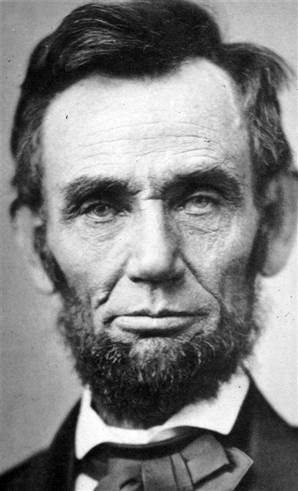
Honest Abe. Roll your mouse over Abe's original portrait to see what Portrait Pro thinks of him. JavaScript required.
We found a portrait of him and ran it through Portrait Pro in just a few seconds. We were half expecting him to switch parties and come out as John Edwards but apart from the softening of his skin texture, it didn't dare to fool around much. Honest Abe, indeed. Or just the lack of color information, perhaps.
We thought we'd give Jimmy Durante a shot at a makeover. The proboscis remained recognizable, the mouth became refined but there was simply no improving those eyes.
Next, Greta Garbo.
The audacity of the program! It wants to know if even Greta is male or female! We straighten it out right away.
Interestingly enough, her nose was a little out of joint, a bit to right. Portrait Professional didn't touch that. But it did give her a slightly stronger jaw, unfortunately. Someone should explain to it that you can't improve on perfection.
But that raised an interesting point. Durante and Garbo were both publicity stills, the kind of prints that would have already been retouched. And Portrait Pro really had little to add. Perhaps there should be a movie star check box, too.
THE BEAUTY BOX | Back to Contents
If you believe the notion that beauty is a reduction of variety toward some mathematically describable ideal, you have plenty of company. The alternate conception that it doesn't exist except in variety, of which movement is an important component, is a little harder to grasp for most Sunday philosophers but should keep you up late at night.
One of the more amusing examples of the mathematical reduction is The Golden Number site (http://goldennumber.net/face.htm) where everything is reduced to Phi (1.618933...). "The human face abounds with examples of the Golden Section or Divine Proportion," the site contends before scribing face after face to prove it.
And in the same league is a Bavarian University of Regensburg research project (http://www.beautycheck.de/) that assembled ideal male and female portraits by averaging a number of real ones (much as if you had a 64 mothers and 32 fathers). The study's conclusion is rather sobering: "To sum up, our study shows clearly that the most attractive faces do not exist in reality, they are morphs, i.e. computer-created compound images you would never find in everyday live. These virtual faces showed characteristics that are unreachable for average human beings."

Skin. The original (left) with default skin imperfection setting of 100 (middle) and Subtle preset of 27 (right). Note also the color shift. We're investigating this issue. Portrait Pro does retain ICC profiles assigned to an image but our Adobe RGB (1998) image didn't survive unscathed.
The German study insisted that the ideal tended toward "babyfaceness," which it defined as "large, round eyes, a large domed forehead and small, short nose and chin." Respondents simply preferred a baby face. "Only very few (9.5 percent) of the test subjects found the original adult faces most attractive. Most of the test subjects (90.5 percent) preferred faces with 10-50 percent the proportions of the babyface scheme."
It should be noted that Portrait Pro's defaults and presets are not based on any of these theories, but on their own research. Portrait Pro was trained by being told which of hundreds of "well-lit photographs of beautiful and not so beautiful people" were attractive and which were not.
It's also worth repeating that this controversial aspect of the program concerns the face sculpting capability. And that certainly has its roots in the portrait painting of the past even as its branches sway in the winds of current research.
You can just turn that off if it bothers you. We found it as annoying as lens distortion for portraits of people we know, but flattering for strangers. But we didn't dare try it on ourselves. We might have bought the thing.
CONCLUSION | Back to Contents
Portrait Pro isn't really about beauty at all, but simple, time-tested flattery. It does simple retouching as well as more dramatic reshaping toward an ideal you may or may not find so ideal. That can't help but interest any professional interested in making a sale. Considering how easy the program is to use, there's nothing to fear, either.
Many of these edits are nothing more than time-honored retouching practice. The sharpened eyes, the whitened teeth and eyes, the more saturated lips, blemish removal are all standard effects, very nicely implemented. Automating things like that is a blessing. They're often very time consuming to do by hand.
But the greater achievement, it seems, is the program's ability to distinguish facial features like skin defects from pores and small wrinkles from the larger ones that define character. Giving you control over these categories of facial features -- as well as being able to store your settings as a preset -- means you can define your own level of flattery.
Portrait retouching software really never looked so good.
